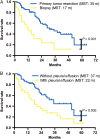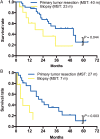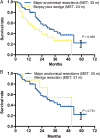Primary tumour resection showed survival benefits for non-small-cell lung cancers with unexpected malignant pleural dissemination
- PMID: 26705302
- PMCID: PMC4986565
- DOI: 10.1093/icvts/ivv353
Primary tumour resection showed survival benefits for non-small-cell lung cancers with unexpected malignant pleural dissemination
Abstract
Objectives: Although non-small-cell lung cancer (NSCLC) with malignant pleural nodules is generally contraindicated for surgery, there is no consensus concerning on-site operative decisions for unexpected, intraoperatively encountered malignant pleural disseminations. The rationale underlying the primary tumour removal and other aggressive interventions remains controversial.
Methods: All surgical NSCLC cases (9576) of Shanghai Pulmonary Hospital between January 2005 and December 2013 were reviewed. Among them, 83 cases (0.9%) met the definition of 'unexpected' macroscopic malignant pleural nodules, despite routine preoperative evaluations for tumour metastasis. No pleural effusion was visualized in 52 cases during operations, and 31 had pleural effusion in minimal volume (<300 ml). Survivals were calculated with the Kaplan-Meier method and risk factors were evaluated by the log-rank test.
Results: The overall 3- and 5-year survival rates were 36.1 and 16.8%, respectively. The median survival time (MST) after surgery was significantly longer in the group without pleural effusion (37 months) compared with the group with pleural effusion (22 months, P = 0.005). Twenty-one cases had only biopsy, whereas 62 cases had primary tumour resection. Primary tumour resection had significantly better outcome compared with biopsy (MST: respectively, 35 vs 17 months, 3-year survival rate 45.8 vs 11.8%, P = 0.001). No baseline differences emerged in characteristics between biopsy and primary tumour resection groups including targeted therapy. Multivariate analysis showed that primary tumour resection (HR: 3.678, P = 0.014), no pleural effusion (HR: 3.409, P = 0.001) and adenocarcinoma (HR: 5.481, P = 0.002) were favourable prognostic factors in patients with malignant pleural nodules.
Conclusions: Patients with malignant pleural nodules but without pleural effusion had better survival compared with those with effusions. Primary tumour resection had survival benefits for patients with unexpected intraoperatively proven malignant pleural nodules.
Keywords: Lung cancer; Malignant pleural dissemination; Prognosis; Surgery.
© The Author 2015. Published by Oxford University Press on behalf of the European Association for Cardio-Thoracic Surgery. All rights reserved.
Figures




Similar articles
-
The prognosis after contraindicated surgery of NSCLC patients with malignant pleural effusion (M1a) may be better than expected.Oncotarget. 2016 May 3;7(18):26856-65. doi: 10.18632/oncotarget.8566. Oncotarget. 2016. PMID: 27057627 Free PMC article.
-
Surgical Outcomes after Pulmonary Resection for Non-Small Cell Lung Cancer with Localized Pleural Seeding First Detected during Surgery.Thorac Cardiovasc Surg. 2018 Mar;66(2):142-149. doi: 10.1055/s-0035-1564928. Epub 2015 Dec 15. Thorac Cardiovasc Surg. 2018. PMID: 26669768
-
No survival benefit of primary tumor resection for non-small cell lung cancer patients with unexpectedly detected pleural disseminated nodules in the era of targeted therapy.Gen Thorac Cardiovasc Surg. 2025 Feb;73(2):102-109. doi: 10.1007/s11748-024-02055-5. Epub 2024 Jul 20. Gen Thorac Cardiovasc Surg. 2025. PMID: 39031333
-
In lung cancer patients where a malignant pleural effusion is found at operation could resection ever still be justified?Interact Cardiovasc Thorac Surg. 2013 Aug;17(2):407-12. doi: 10.1093/icvts/ivt153. Epub 2013 May 8. Interact Cardiovasc Thorac Surg. 2013. PMID: 23656925 Free PMC article. Review.
-
Current readings: the most influential and recent studies regarding resection of lung cancer in m1a disease.Semin Thorac Cardiovasc Surg. 2013 Autumn;25(3):251-5. doi: 10.1053/j.semtcvs.2013.08.002. Semin Thorac Cardiovasc Surg. 2013. PMID: 24331148 Review.
Cited by
-
Primary tumor resection of non-small cell lung cancer patients with ipsilateral pleural dissemination (M1a) in the era of targeted therapy.Thorac Cancer. 2020 Nov;11(11):3213-3222. doi: 10.1111/1759-7714.13649. Epub 2020 Sep 18. Thorac Cancer. 2020. PMID: 32946207 Free PMC article.
-
Prognostic Value of Surgical Resection for Non-small-cell Lung Cancer Patients Comorbid With Minimal Pleural Effusion.Cancer Control. 2025 Jan-Dec;32:10732748241311223. doi: 10.1177/10732748241311223. Cancer Control. 2025. PMID: 39760513 Free PMC article.
-
Surgical intervention for non-small-cell lung cancer with minimal malignant pleural effusion.Surg Today. 2023 Jun;53(6):655-662. doi: 10.1007/s00595-022-02606-4. Epub 2022 Oct 31. Surg Today. 2023. PMID: 36310332
-
Complete resection of the primary lesion improves survival of certain patients with stage IV non-small cell lung cancer.J Thorac Dis. 2017 Dec;9(12):5278-5287. doi: 10.21037/jtd.2017.11.67. J Thorac Dis. 2017. PMID: 29312736 Free PMC article.
-
Comprehensive analysis of surgical strategies and prognosis for non-small cell lung cancer with pleural metastasis detected intraoperatively.BMC Cancer. 2024 Oct 22;24(1):1303. doi: 10.1186/s12885-024-13029-4. BMC Cancer. 2024. PMID: 39438866 Free PMC article.
References
-
- Sugiura S, Ando Y, Minami H, Ando M, Sakai S, Shimokata K. Prognostic value of pleural effusion in patients with non-small cell lung cancer. Clin Cancer Res 1997;3:47–50. - PubMed
-
- Jett JR, Scott WJ, Rivera MP, Sause WT. Guidelines on treatment of stage IIIB non-small cell lung cancer. Chest 2003;123:221–5. - PubMed
-
- Goldstraw P, Crowley J, Chansky K, Giroux DJ, Groome PA, Rami-Porta R et al. . The IASLC Lung Cancer Staging Project: proposals for the revision of the TNM stage groupings in the forthcoming (seventh) edition of the TNM Classification of malignant tumours. J Thorac Oncol 2007;2:706–14. - PubMed
-
- Webber C, Gospodarowicz M, Sobin LH, Wittekind C, Greene FL, Mason MD et al. . Improving the TNM classification: findings from a 10-year continuous literature review. Int J Cancer 2014;135:371–8. - PubMed
-
- Fukuse T, Hirata T, Tanaka F, Wada H. The prognostic significance of malignant pleural effusion at the time of thoracotomy in patients with non-small cell lung cancer. Lung Cancer 2001;34:75–81. - PubMed
Publication types
MeSH terms
LinkOut - more resources
Full Text Sources
Other Literature Sources
Medical
Miscellaneous

